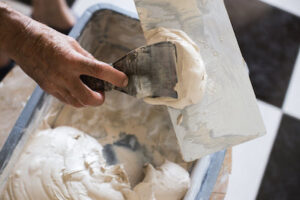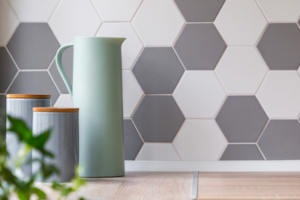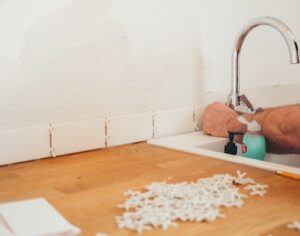Complete Guide to Epoxy Grout for Kitchen Tile
The kitchen, for many, is the heart of the home. Its tiles experience the most traffic and often the most accidents. Therefore, the materials you use are important. There are many options to choose from regarding what to use to lay your kitchen tile. Epoxy grout, however, has become increasingly popular in recent years due to its strength and water tightness. However, is it right for you?
Should I use epoxy grout to lay my kitchen tile? For most kitchens, epoxy grout is not the best option. Epoxy grout has some advantages, but it is not the easiest material to work with and may prove more costly than other options. Additionally, it can become incredibly slippery, making it ill-suited for some kitchen spaces.
This article will provide the benefits and disadvantages of epoxy grout to help you decide whether you want to use it to lay your kitchen tiles.
What is Grout?
Grout is the material used to fill the gaps between tiles. These are often cement-based and while it can be grouted with almost any material, it is not waterproof.
What Makes Epoxy Grout Different?
 Epoxy grout is a type of mortar. Unlike other types of grout, it cures within hours and is waterproof; making it ideally suited for tiling over a kitchen, bathtub, or shower surround which can be exposed to moisture.
Epoxy grout is a type of mortar. Unlike other types of grout, it cures within hours and is waterproof; making it ideally suited for tiling over a kitchen, bathtub, or shower surround which can be exposed to moisture.
Epoxy grout has been becoming more popular over the last few years. Many people swear by it, saying that it is easier to work with than traditional thin-set mortar when you’re setting tile on top of your countertop.
There are many advantages to using epoxy grout to lay your kitchen tile, including quick installation time, durability, less mess during clean-up, water resistance, and stain resistance. Like everything, there are also disadvantages to using epoxy grout including the cost.
To determine whether epoxy grout is the best option to use to lay your kitchen tile, it may be helpful to consider the pros and cons.
How It Is Used
Epoxy grout is essentially a liquid that you mix until it’s thick enough to use. You can use this mixture right away without needing another step or waiting for it to dry. This allows you complete control over how much epoxy grout gets applied at one time. It also means that the epoxy grout won’t start to harden before you get a chance to lay all of your kitchen tiles.
Epoxy grouts are often recommended for use in kitchens and bathrooms since they can be cleaned with just soap and water, so food and dirt have no place to hide.
Benefits of Using Epoxy Grout
There are many benefits to using epoxy grout for your kitchen tile.
Waterproof
While tile is waterproof on its own, epoxy gives that extra level of protection while increasing durability. It also allows tiles to last longer than other types by protecting their surfaces from stains and scratches.
Color Options
 Epoxy grouts are available in many different colors. Whether your style is minimalist or bold you should be able to find one that suits your taste. Colors range from classic grays and whites to bolder blues, greens, purples, pinks, reds, browns, and blacks.
Epoxy grouts are available in many different colors. Whether your style is minimalist or bold you should be able to find one that suits your taste. Colors range from classic grays and whites to bolder blues, greens, purples, pinks, reds, browns, and blacks.
Salt Damage Resistant
Epoxy grouts are also resistant to salt damage. It can keep up with high use where other types of grouts might not.
No Harmful Chemicals
Many people also like the fact that epoxies do not contain any harmful chemicals such as VOCs (volatile organic compounds). This means that their home will not become contaminated with these potentially dangerous substances when they install their new kitchen tiles.
Mortar Alterative
Epoxy is also an excellent alternative to mortar for outdoor spaces where moisture can be problematic. As epoxy sets quickly there’s no chance of it drying unevenly as mortar would, and it doesn’t allow any room for moisture to penetrate the grout.
Long-Lasting
Epoxy is a good choice for any area where negligence might cause damage from water, oils, or chemicals. If you’re looking for a grout that will help your tile last as long as possible and protect it from damage then epoxy is a great option both aesthetically and practically.
Disadvantages of Epoxy Grout
While there are many advantages to using epoxy grout, there are also several disadvantages.
Slippery
Epoxy grout becomes incredibly slippery when wet. This can lead to unexpected falls or accidents if it is laid on the bathroom floor, for example. It also becomes even slippier as time goes by due to wear from sharp objects such as kitchen knives and other utensils scraping over the surface.
Cost
Epoxy grout is more expensive, costing more than traditional non-flexible grouts. The price of epoxy grout depends upon the brand that you use and on the size of your tile installation. However, epoxy grout typically costs two to four times as much as regular latex mastic or fiberglass resin mortar bedding compound for tile installations.
You can expect to pay about $40 per 50 pounds bag of epoxy grout for small tiling projects, but prices are rising due to strong demand for this product among DIYers, who are buying three-pound bags at hardware stores. You can save money if you purchase epoxy grout in bulk online.
Messier
 Epoxy grouts are messier than traditional latex-based materials and require more labor to clean up after installation.
Epoxy grouts are messier than traditional latex-based materials and require more labor to clean up after installation.
This adds to the overall cost of the installation. Cleanup takes longer with epoxy grout because it gels before it dries.
It remains gooey for several hours at room temperature and therefore is messy when not properly cleaned up immediately after use. Dismissing this fact will result in a less than optimal finished product.
Grouted tile looks best when the joints are free of adhesive residue that leaves textured marks on the surface of the tiles or in areas above or below where they are applied.
Touch Ups
Traditionally, grout is used to fill the space between tiles. Epoxy grout, however, acts as both adhesive and mortar so they can be used to bond tiles together. Epoxy grouts are very strong compared with standard mastic materials which attract dirt and require recoating every two or three years because of their poor durability.
This means that regular latex or vinyl sealer must be used after tiling with epoxy grout to keep the surface of the tile free of dirt and debris that can scratch it. Sometimes, sealing may not adequately protect certain surfaces, such as granite countertops. These are also hard to clean if you accidentally spill epoxy on them during installation or after using this product.
Shrinkage
This material also shrinks 5% after application. Precision is required when applying this product at joints or narrow spaces because if you don’t apply enough adhesive to fill the gap between tiles, it will be noticeable.
The shrinkage also affects the joint between two pieces of tile laid with this material. You should allow for twice as much epoxy as you think you will need to fill the gaps between tiles. Using less may leave an uneven joint that is noticeable through your finished tile surface.
Shrinkage also leaves a gap behind tiles if they are not pressed firmly against the substrate; this can cause delamination (lifting) if they are allowed to stick out above the rest of your tiling project.
No matter what type of grout is used, it’s important to press tiles firmly into place so they bond together tightly and won’t shift or move after tiling with them.
Curing Time
The curing time for epoxy grout is much longer than traditional non-flexible grouts. It takes 24 hours to fully cure, so humidity delays that process.
Non-flexible grouts cure one to two days after installation even if they are exposed to high humidity during that time. Epoxy grouts, however, do not become hard until at least 24 hours have passed since installation.
This type of grout sould always be allowed to cure before use or being walked on or cleaned so you should wait two full days after application before allowing foot traffic onto the area, whether it’s tile or carpeting.
Epoxy Grout Options
Epoxy grout comes either in a kit or in a pre-mixed package. The parts that make up each epoxy kit will vary depending on whether it’s a two-part kit or a single-part kit.
In most cases with a two-part epoxy kiln, you won’t know which size of the kit you’ll need until after your contractor measures out the space. Because epoxy grout has such a wide range of uses, only one size will generally get the job done.
Two-part kits usually include 1/2 gallon or 5 gallons of uncolored epoxy resin and 1 quart or 5 quarts of hardener. One part kits usually come in 5 gallon buckets and can also be tinted to match any color you need
Most people choose to use epoxy when they have a very tough grout line that needs something stronger than what standard grouts offer. This is especially true when they have an area in their home that gets high traffic or has a higher chance of getting spills on it. Therefore spaces like kitchen floors are sensible locations to utilize epoxy grout.
In Conclusion
Tile can make or break a space, especially one that is so often used. It’s important to think carefully before committing. As you consider the best options for your upcoming tile installation, epoxy grout may be a great choice that will help your tiles retain their aesthetic over time.
